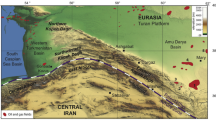Abstract
The variogram method can be used to make a fractal model of a rock joint surface. However, it has been found that the range of lag satisfying the power law is very small, that is, less than about 10% of the profile length. The cause of this has been investigated mathematically. The main cause of this problem is due to the fact that the profile length is assumed infinite for the theory, but it is finite for the actual calculation. This discrepancy between the actual calculation and the theory yields a significant error and causes the problem when the lag is large. To confirm the validity of this conclusion, it has been demonstrated that the range of lag satisfying the power law increases with an increase in the profile length by applying the variogram method to profiles cut from a long profile. In addition, the range of lag was investigated mathematically and it has been clarified that the range of lag increases with an increase in the fractal dimension. These results suggest that the profile length, the sampling interval and the removal of the linear trend are items to which we must pay attention when we use the variogram method.
Similar content being viewed by others
References
Brown, S.R. and Sholz, C.H. (1985) Broad bandwidth study of the topography of natural rock surfaces, J. Geophys. Res., 90, 12575-82.
Brown, S.R. (1995) Measuring the dimension of self-affine fractal: example of rough surfaces. In Fractal in the Earth Sciences, Barton, C.C. and La Point, P.R. (eds), Ch. 4, Plenum Press, New York, pp. 77-87.
Falconer, K. (1990) Fractal Geometry, Ch. 16. John Wiley & Sons.
Huang, S.L., Oelfke, S.M. and Speck, R.C. (1992) Applicability of fractal characterization and modeling to rock joint profiles, Int. J. Rock Mech. Min. Sci. & Geomech. Abstr., 29, 89-98.
Kulatilake, P.H.S.W., Shou, G., Huang, T.H. and Morgan, R.M. (1995) New peak shear strength criteria for anisotropic rock joints, Int. J. Rock Mech. Min. Sci. & Geomech. Abstr., 32, 673-697.
Kulatilake, P.H.S.W., Um, J. and Pan G. (1998) Requirements for accurate quantification of self-affine roughness using the variogram method, Int. J. Solids and Structures, 35, 4167-4189.
Mandelbrot, B.B. (1983) The fractal geometry of nature. W.H. Freeman and Company, New York.
Peitgen, H.-O. and Saupe, D. (1988) The science of fractal images, Ch. 1. Springer-Verlag, New York.
Power, W.L. and Tullis, T.E. (1991) Euclidean and fractal models for the description of rock surface roughness, J. Geophys. Res., 96, 415-24.
Rengers, N. (1970) Influence of surface roughness on the friction properties of rock planes, Proc. of 2nd Congress of I.S.R.M. Vol. 1, Beograd 1970, pp. 229-34.
Schmittbuhl, J., Schmitt, F. and Scholz, C. (1995) Scaling invariance of crack surfaces, J. Geophys. Res., 100, 5953-73.
Swan, G. and Zongqi, S. (1985) Prediction of shear behavior of joints using profiles, Rock Mech. and Rock Eng., 18, 183-212.
Xie, H. (1993) Fractals in rock mechanics, Ch. 2. A.A. Balkema, Rotterdam.
Author information
Authors and Affiliations
Rights and permissions
About this article
Cite this article
Murato, S., Saito, T. The variogram method for a fractal model of a rock joint surface. Geotechnical and Geological Engineering 17, 197–210 (1999). https://doi.org/10.1023/A:1008917503259
Issue Date:
DOI: https://doi.org/10.1023/A:1008917503259




